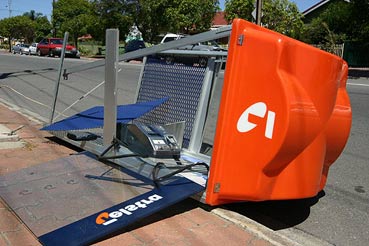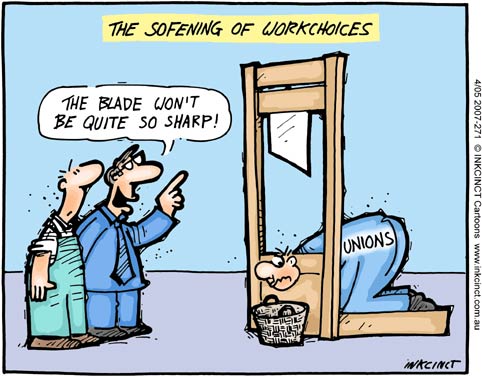I figured I will put something different out on the FTTN proposal I put up last night, simply because where I got to, I thought.. Wouldn’t it be good to try and answer the majority of the questions based around the same model that is based around open source.
The idea is sparked essentially from the common belief that the internet is an open network for freedoms, with the exception that laws in the states / countries where the content originates still apply.
Open Source software is not really much different, in the same model that it is placed up in a manner where others contribute to it, and the laws of the state / country apply where the software is peiced together. There’s laws about encryption of data in some countries for example, so those would apply in much the same way.
The internet is generally believed to be a wide open network, where you can access any content put out there by contributers to the internet, which makes it a great resource medium for information, as well as an entertainment medium and a self expression medium.
Open source, the same, I believe many open source software authors put the time into the software they do as a “art” or “self expression”, and others because – someone had to do it, and they figured they’d enjoy the challenge / the project, again, self expression.
Anyway, that’s not really too relevant to an Open Source FTTN network. I’ll be basing the same points required to submit a proposal to the Expert Taskforce here, except putting forward an open source model.
I think it might come out interesting, if not actually in real life – yeh, not likely.
Project Title:
OSN – Open Source Networks
Name of proponent:
OSN – Open Source Networks
Consortium members:
Every consumer of the public
Proposal summary:
Technical: The open source networks model works by providing a network which is open source, that is, the network is contributed to by the users of the software. The user seeking a connection would make their own fibre connection to the chosen point of interconnection. This would be in a place where a key project maintainer would be placing the parent project node, and users can contribute to that, by connecting their own premises to the node using fibre optic cable.
Geographical coverage: The project would start in many areas, with many project maintainers starting up nodes where they felt fit to start one, and then it would be a combined effort of the key project maintainers in two neighbouring areas to link the two areas together to gain connectivity to the core network, which would be contributed to by all project maintainers and provide all connectivity to all the project users. International connectivity would be provided also through those links. The coverage of the network is limitless, anyone can choose to connect to the network, or start their own sub network of the project, and project users may connect themselves to which ever project maintainer they choose to.
Scalability: The network is likely to be upgraded by project maintainers. Should a project maintainer not upgrade a network in a timely manner, others are free to instead become a new project maintainer and get project users connected to the network. Both the old and new network would exist, and any additional networks are able to be ran alongside existing networks.
Proposed wholesale, retail price, non-price terms, conditions and data speeds:As the network is open source, users are free to upgrade or downgrade to any speed of access as they like, the project maintainers job will be to ensure that the project section they maintain is capable of providing connectivity at any unsustainable rate, as a measure of future proofing. Project maintainers of shared areas for prime connectivity have a role to keep both sides of the network with speeds above what is sustainable by all users on the network. This is done by adjusting the speed of the link, or upgrading, adding links where necessary. There is no price terms necessary as all hardware and equipment is funded by the projects users, since they will be using and contributing to the network they will be bearing all network costs.
Proposed total expenditure: The project needs only a small section for maintaining project data, which can be web driven so only requires a server. The other costs, such as international transit will be expenses split among all project maintainers in exchange for them owning the network they hold and therefore being free from infrastructure expenses.
Scope of regulatory and legislative changes: There are no changes needed in this area, as the network is completely open, and regulations shouldn’t be applied, due to the users paying and maintaining and no such retail service existing.
Summary of proposal against Australian Government Objectives:
Timely roll-out and operation of new, privately funded, open access, high speed broadband network infrastructure in Australia’s capital cities and major regional centres that:
a) provides higher quality and faster wholesale and retail broadband services than those now available in those areas, and
b) enables future network infrastructure and service improvements over time.
Answer: This objective is met by the network being open and free for anyone to expand upon, add to, modify, recompile (well, not necessary recompile), etc. The network provides no wholesale or retail services, since the users won’t require any.
The above outcome is acheived in a way that promotes the long term interests of end-users and is consistentwith the following broader policy objectives of the Australian Government:
a) an industry environment characterised by sustainable, robust competition between market participants, supported by open, non-discriminatory network access arrangements.
b) economically effecient investment in, and use of telecommunications network infrastructure.
c) people having access at competitive prices
d) commercial returns commensurate with costs
e) consistent with international trade obligations
Answer: As the nework is open, users contribute to keeping it running entirely on their own. They plug themselves in, source their own hardware, make donations to the project maintainer and to the project management. no retail or wholesale services supplied, and it’s a FTTH network, therefore it will be a Faster Than Telstra’s Network, direct to the home. International trade obligations don’t apply.
a) Proposed legislative or other regulatory changes to the telco regime should be demonstrably linked to the facilitation of a particular porposal.
b) legal and other risks to the commonwealth should be minimised and
c) compensation to affected parties
Answer: There is no legislative or regulatory changes required. There is no legal risks to the commonwealth. There are no compensation amounts to any idiots due because the network is a new network, and simply puts the idiots own copper network alone to rot away, like they plan on doing anyway, by not upgrading to FTTN any sooner.
Project costs:
The project has minimal costs in the order of $10,000 through to $100,000 to get up and running, after that users carry their own costs of service, and recovery of any initial aggregate costs will be capable of being done by donations by users and cost contributions where required by users to project maintainers, and project maintainers and users to project management, where required for adminstration of the network.
Index of annexures:
There are no annexures.
Additional confidential information:
Unlike some, we have nothing to hide with a completely open network.
Proponent details:
Name: Open Networks
ACN: NA
ABN: Not For Profit
Registered Office Address: 1 Open Network Way
Postal Address: Locked bag open
Place and date of incorporation: NA
Name of parent company: Not Greedy Pigs Inc.
Principal contact:
Name: Project Management
Position: Project Management
Postal Address: Locked bag open
Mobile phone: 10100010001000100030001
Fax: Binary write socket 12414.
Email: open@open-networks.org
Consortium members:
A Australian
B Australian
C Australian
— Essentially the entire Australian consumers are the members.
Network infrastructure design and technical specifications:
Network infrastructure and architecture: Any fibre optic equipment users and maintainers wish to connect to the management fibre optic network.
Services: Services will be FTTH, and carry as much data as a user provisions at, with whatever the project maintainers equipment allows, and gets funded for upgrades to.
Capacity: More than you’ll ever see from Telstra.
Scalability: The network is capable of speeds faster than are currently used anywhere in the known world, except for the woman with a 40Gbps connection. I hear she has issues with shaping to 64k after just 40GB.
Future proof: As the network is open, it’s as future proof as you are going to get, with anyone able to upgrade any section of the network any way they like.
Redundancy: Is built into the open model. All Project users in an area can be project maintainers if they want and effectively be redundant off each other. Security: All data leaving a users premises can be encrypted if they want it to be.
Open access: Service providers don’t exist in this model, but it is open access, any one can connect.
Interoperability: Due to the nature of fibre, any user can upgrade to it and run at any speed they like, any compatible fibre equipment they like.
Suitability of technology: The technology is used worldwide for networking nations to nations. It’s suitable.
Network coverage:
Network coverage is really anywhere you need or want it. Run the cable there yourself. Done.
Timeframe:
The entire network could be complete within 14 days if every single user upgraded simultaneously and connected together simultaneously. The timeframes are user dependant. If they want it tomorrow, they connect it tomorrow.
Network construction and operation:
Construction: the network is constructed by users, do it themselves, pay someone to do it, whatever they see fit.
Equipment and systems: There is only a need to maintain one system at the core of it and that’s the maintenance system to determine capacity usage over international links, the rest of the network is maintained by the users.
Operation: The network is operated and maintained by users.
Migration: Users plug themselves in when they want to / pay someone to do it for them.
3.5 Retail services and price and non-price terms and conditions of retail services
No retail services supplied.
Consumer outcomes:
Speeds are at whatever the user sets them at, the availability is at what the users make it available at, the prices are non-existent, the quality and reliability are up to the users.
Choice doesn’t matter when it comes to a $0 service. Users can make the service whatever they want it to be.
Efficiency:
The network can be as efficient as the users make it. Use of the infrastructure is up to the users.
Competition:
Competition exists among project managers, though they aren’t really competing for any monetary or value item, but rather if they wish to, they can compete on upgraded networks where network upgrades are needed, in a FTTH deployment, these are generally not needed for anything often.
Open and non-discriminatory access:
Everybody has open access. There’s no discrimination possible when the users aren’t able to discriminate against themselves.
Wholesale information strategy:
What does wholesale mean? We don’t do any wholesale.
Wholesale pricing:
Free.
Contribution towards any network losses in rural and remote areas:
A: Provide views on whether prices should include a contribution towards losses:
Answer: There’s no loss in a user pays network.
B: If the proposed prices for wholesale services described above include contribution, identify amounts of losses:
Answer: There’s none.
Legislative and other regulatory changes:
There is no legislative or regulatory changes.
Compliance with legislative or other regulatory requiments:
There is no compliance needed as the sale of services doesn’t occur.
Binding commitments:
The only single commitment here is that the user plugs themselves in. If they have to run a cable round a pole, so be it. If they have to dig a ditch so be it, if they have to follow the path the existing cable into their own home takes, so be it. There’s no commitment required above the user connects commitment.
Assurances sought by the proponent:
No assurances are needed, the network is open, funded by users, made possible by users. Demand satisfies itself.
Corporate structure:
There’s no corporation.
Roles and responsibilities of consortium members:
The only role users (also members of the project) have are that they must plug themselves in and maintain the connection themselves, and project maintainers allow connection to project users where suited, or project users can become project maintainers by their own choice.
Consortium agreement:
The agreement of all users is essentially done when the user connects themselves.
Roles and responsibilities of key stakeholders:
Project Management is to ensure the connections to the international links and between the two project maintainers linked to it are capable of connectivity.
All project maintainers are required to make sure their own connecting networks are connected.
All project users must connect themselves, or pay for someone to do that for them.
Proponent risk:
All risks are taken on board by the project maintainers / project users. No financial risk is taken by anyone, as users connect themselves, and so take the full costs into account (and naturally don’t need to pay monthly fees as a result).
Commonwealth risk:
There is none.
Third party risk:
There is none. Users connect themselves, and therefore accept responsibility for their own connection.
Financial and performance guarantees:
Performance can be as fast as the users choose to go. Finances are up to the users alone.
Financial capability:
There is no finances.
Business case:
Free, fast, unlimited internet access. Sounds like a good business case to me.
Budget summary:
Year 1 – 15+: $0.
Summary of project funding:
The users fund it themselves. We cannot readily determine if that will be on the Visa card, or otherwise.
Management capability and experience:
Management is done in such a way that it is open to all. Experience isn’t really a required point here, as any expert or not can freely go over the details themselves and adjust accordingly.
Project management:
The project manages itself through the users. The only central management required is addressing and lists of project maintainers.
—
And there you have it.
An open network model that works by the users funding the network themselves. If they want connection (this includes big business, small business, government, residential), they run the connection themselves, and others can make arrangements to connect to that network by running their own.
Essentially what is likely to occur is governments, big business will want to join the network and so will run their own fibre cables to their own premises, and whilst those are being rolled out others are able to connect to that same link, avoiding the need to run fibre alongside it. The end result is the project manager can easily upgrade the network, or users can also become project managers and therefore become a point for users to connect through and gain access to upgraded network infrastructure.
All the users manage the connect themselves, maintain services themselves, and maintain connectivity in their own way.
The goverment or big business in the above example would be responsible for their side of the link, and the other end would be responsible for the other half of the link, thereby ensuring that both are responsible for keeping that link stable, or users can again, run a redundant additional link anyway they like to another point of interconnection.
It’s not too far fetched now I consider that, because all of that is generally speaking, possible in many of the metro areas considered, and it is easily extended by others who want to take the service further and further across the nation, or even start up a second point and link all points through their own choosing.
The network is completely open and left for everyone to maintain to ensure its upkeep, the theory is everyone will want access, everyone will contribute to keeping the network expanding or upgraded, and those that don’t can feel free to go without by not connecting – though no one will want to miss out on FTTH, and therefore avoid phone and internet bills altogether.
Should international capacity become a problem, a user pays method would see an additional cable put in, through the use of a donation system, or a contribution system where it is calculated the costs of an additional cable, and the cost per user would be calculated. Users could pay that much, or even donate more.
The project is free from commercial influence because it is ran by users, and users would almost certainly refuse commercial intervention and therefore be billed again for services they can get for free or donate to support.
Enjoy!








